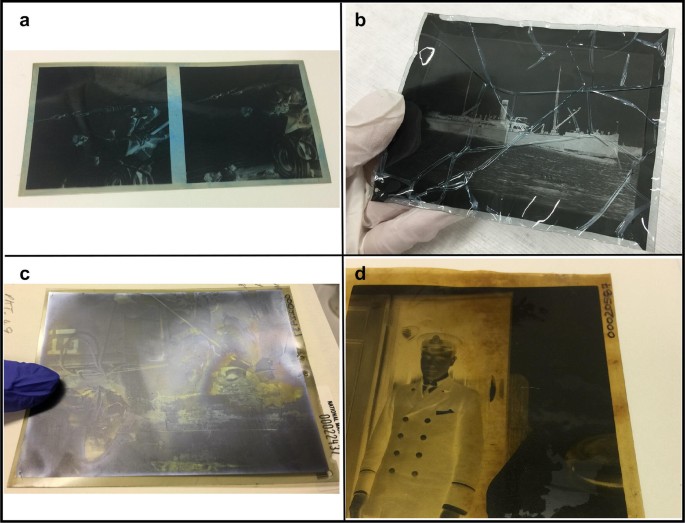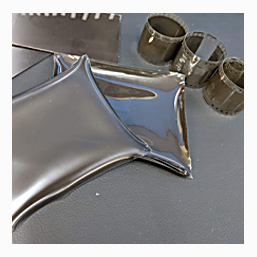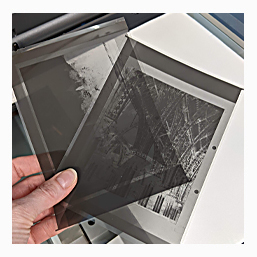Cellulose Photographic Nitrate Film Digitising Solutions in Oxford UK
Archiving and Scanning Digitisation at Oxford Duplication Centre

Identification of cellulose nitrate and cellulose acetate | Nitrate Film | Safety Acetate Film | Polyester Film to Archive Industry Standards
motion & cine film | audio | video | optical | photographic film | books | documents | Scan on Demand | FAQs
Nitrate film can be identified by silver mirroring and yellowing
Our services are highly recommended in the UK, providing high quality precision still photographic film scanning solutions for all your digital media requirements to National Archives Standards. Output digital files can be in any format, with typically any archive file converted to TIFF, with JPEG or PDF access files. We can support clients with any output dpi requirements from preservation copies to digital online files.
Cellulose nitrate film was the first widely used flexible plastic film. In the late nineteenth century it supplanted heavy, fragile glass plates. Unfortunately, cellulose nitrate film degrades as it goes through several distinct stages. The beginning starts with silver mirroring and yellowing. Then it may become sticky and smelly (nitric acid odor). Gradually the negative changes to an amber color with the image beginning to fade. Eventually the negative can soften to a point where it may stick to adjacent pictures or its enclosure. In the final stage it turns to a brown acidic powder. As deterioration progresses it accelerates and in the last stages the film may begin to generate its own heat and ignite. A cellulose nitrate fire doesn’t need oxygen to burn so most of the usual firefighting methods won’t put it out.
A photographic collection that contains any flexible, transparent film negatives from the time period of 1890-1950 is very likely to contain at least some nitrate film. Cellulose nitrate was the plastic commonly used for film-base photographic materials (stills, movie and X-ray films) otherwise known as celluloid which can be hazardous if not stored correctly. More modern film is acetate or polyester-based, which is less hazardous.
There are Six Levels of Cellulose Nitrate Negative Film Decay
Level 1: No deterioration
Level 2: Orange film discoloration and fading images
Level 3: The emulsion is adhesive and films stick together; film becomes brittle
Level 4: The film contains gas bubbles and gives off a noxious odour
Level 5: The film is soft, welded to adjacent film and frequently covered with a viscous froth
Level 6: The film mass degenerates into a brownish acrid powder
Levels 1 - 3, the film can be copied. At Level 4, it may be possible to copy parts of films. At Levels 5 and 6, the film is useless and should be immediately destroyed by your local fire station because of the dangers of spontaneous combustion and chemical attack on other films.
What Do the Nitrate Film Negatives Look Like

Photographic images showing examples of characteristic deterioration used to identify known cellulose nitrate and cellulose acetate samples, graded on the signs of visible deterioration. The deterioration of cellulose nitrate and cellulose acetate cannot be reversed. Low temperature storage is used by many heritage institutions to delay or slow down deterioration.
(a) Cellulose acetate showing level 2 blue coloured anti-halation dye separation deterioration
(b) Cellulose acetate showing level 6 channelling deterioration
(c) Cellulose nitrate showing level 2 iridescent mirroring
(d) Cellulose nitrate showing level 4 amber discolouration
The original nitrate negatives are usually one of these sizes: 35mm or 2 1/4 inch roll film, or 3x4" or 4x5" sheet film. Some 5x7" and 8x10" sheet films were also used.
How to Identify Nitrate Film Decay
- Labels: Check to see if the word ‘Nitrate’ is embossed or printed on the edge of the film. Some nitrate films have been copied onto less-flammable safety film, which might have the words ‘Nitrate’ and ‘Safety’ printed on the film.
- Deterioration: If film is in any of the Levels of decay we noted above, assume it’s nitrate. But if the film is wrinkled or smells like vinegar, it’s most likely safety film.
- Dates:
- Assume that any film dated before 1920 is nitrate film.
- Look for notches on the edge of any Kodak film dated from 1921 to 1940. Hold the film with the notches in the upper right corner. If the first notch from the right is shaped like a ‘V,’ you’re holding nitrate film. If the first notch looks like a ‘U,’ it’s most likely safety film.
- For non-Kodak film from 1921 to 1940, all film from 1940 to 1950, and any film that can’t be dated – look for the signs of deterioration we mentioned above.
Don't Wait Too Long to Digitise Your Archives
In the 1980s it was estimated that the majority of nitrate film would have decomposed by 2000. However, through a systematic process of copying and by deep-freezing film, archivists have effectively bought themselves further time to tackle the problem. But during the last 20 years another problem, this time with acetate safety film—vinegar syndrome—has arisen which also needs to be tackled.











